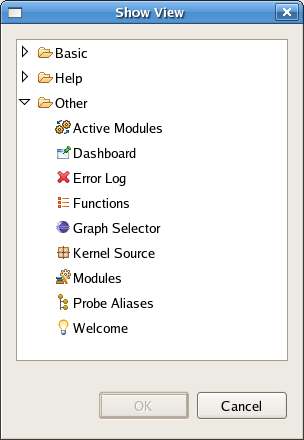Notice: this Wiki will be going read only early in 2024 and edits will no longer be possible. Please see: https://gitlab.eclipse.org/eclipsefdn/helpdesk/-/wikis/Wiki-shutdown-plan for the plan.
Linux Tools Project/Systemtap/User Guide/ide/menus.html
IDE Perspective Menus
What follows is a comprehension list of the menu options available within the IDE Perspective of Systemtap GUI.
File
- New File - This option will bring up a dialog to create a new file. You may specify any location. Files ending in a .stp or .c extension will have syntax highlighting and code completion features as appropriate. (Shortcut: Crtl+L)
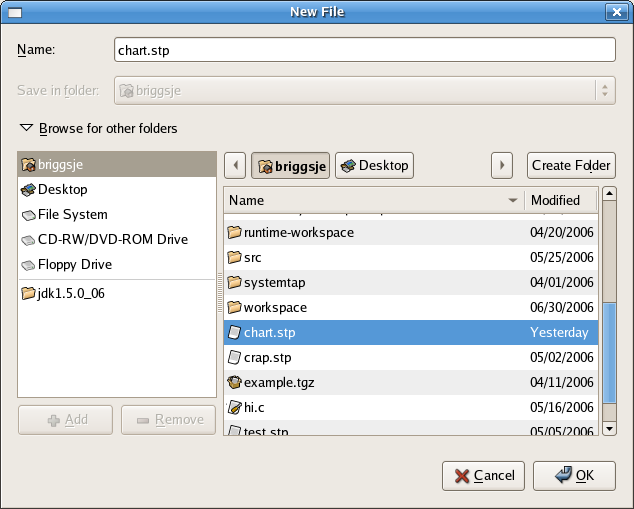
- Open File - This option will bring up a dialog to select a file to open. Once a file is selected it will open in the editor window. (Shortcut: Crtl+O)
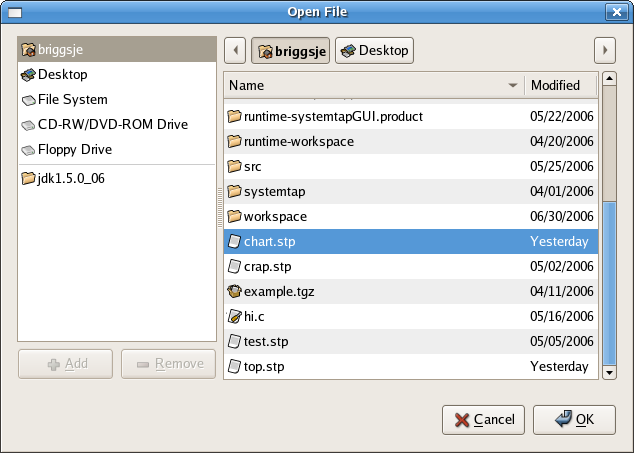
- Close - This option closes the file in the editor pane that currently has the focus. (Shortcut: Crtl+F4)
- Close All - This option closes all files in the editor pane. (Shortcut: Shift+Crtl+F4)
- Save - This option saves the file that currently has the focus. (Shortcut: Crtl+S)
- Save As - This option prompts the user for a new location and file name and saves the file that currently has the focus under that new name and location.
- Save All - This option saves all files currently open in the editor pane. (Shortcut: Shift+Crtl+S)
- Revert - This option discards changes to the file currently under the focus replaces it with the last saved version.
- Print - This option prints the file in the editor pane currently holding the focus. (Shortcut: Crtl+P)
- Export Script - This option prompts the user to enter metadata associated with the Systemtap script to be exported and used in the Dashboard perspective. See the Creating Modules guide for instructions.
- Import Tapset - This option allows you to include additional tapset directories when you run a script. (Shortcut: Crtl+I)
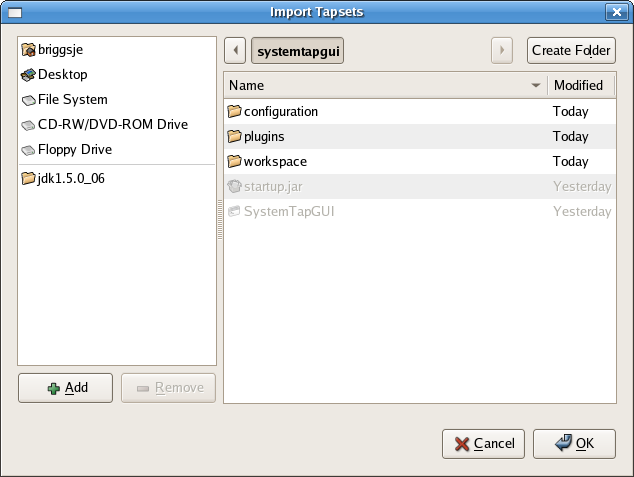
- Exit - Exits Systemtap GUI.
Edit
- Undo - Undos the previous editor related action. (Shortcut: Crtl+Z)
- Redo - Redos the previous editor related action removed by Undo. (Shortcut: Crtl+Y)
- Cut - Removes the selected text from the editor pane and places it in the clipboard. (Shortcut: Shift+Delete, Ctrl+X)
- Copy - Copies the selected text from the editor pane and places it in the clipboard. (Shortcut: Ctrl+Insert, Crtl+C)
- Paste - Copies the text from the clipboard to the location of the focus in the editor pane. (Shortcut: Shift+Insert, Crtl+V)
- Select All - Selects all text within the file in the editor that the focus is currently in. (Shortcut: Crtl+A)
- Find/Replace - Opens the Find/Replace dialogue in which users may specify a text string to find and/or replace, with options to search forwards or backwards, the entire document or just the selected lines, and whether or not they want the following options:
- Case sensitive
- Wrap Search
- Whole Word
- Incremental
- Regular expressions
- Find Next - Finds the next instance of the search string in the direction indicated in the Find/Replace dialogue box. (Shortcut: Crtl+K)
- Find Previous - Finds the previous instance of the search string in the direction indicated in the Find/Replace dialogue box. (Shortcut: Shift+Crtl+K)
- Incremental Find Next - Finds the next occurrence of the text and updates the selection after each character typed. To use Incremental Find:
- In the text (or Java) editor, press Ctrl+J or select Edit > Incremental Find Next from the menu bar.
- The workbench status line displays "Incremental Find:". The editor is now in the Incremental Find mode.
- As you type, the editor finds the next occurrence of the text and updates the selection after each character typed.
- Navigate to the next or previous match by pressing Arrow Down or Arrow Up.
- Undo the last action within the Incremental Find mode by pressing Backspace.
- You can leave the Incremental Find mode by pressing Esc
- Incremental Find Previous - Operates as illustrated in above bullet but in the reverse. (Shortcut: Shift+Crtl+J)
- Select All - Selects all the text in the file that currently has the focus. (Shortcut: Ctrl+A)
- Word Completion - Completes the string being typed by using the last example typed by the user. (Shortcut: Alt+/)
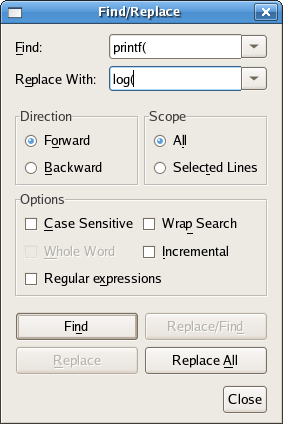
- Forward - Navigates to the next file in sequence as they were opened in the editor pane. (Shortcut: Alt+Right)
- Back - Navigates to the previous file in sequence as they were opened in the editor pane. (Shortcut: Alt+Left)
- Last Edit Location - Moves the focus to the file containing the last known edit. (Shortcut: Crtl+Q)
- Goto Line... - Moves the focus to the specified line number, with the range of line numbers listed in the dialogue box. (Shortcut: Ctrl+L)
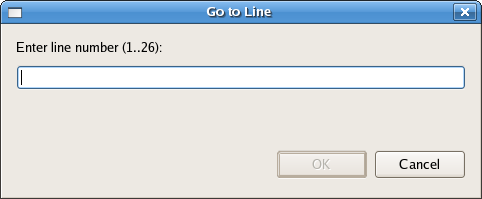
Run
- Run - Available when a Systemtap script is loaded into the editor, this feature runs the script. You will be prompted to enter details of the remote machine running the systemtapgui server.ShortCut(Ctrl+F5)

- Run w/Chart - Available when a Systemtap script is loaded into the editor, this feature will prompt the user for the number of columns for the chart, in addition to their titles and regular expressions. The regular expressions are used to parse the console output for the script and determine the values of each column at a certain sample point. The combined regular expression is shown at the bottom of the dialogue box. The user has the option to use Command Line Options as well. When you click OK you will be prompted to enter the details of the remote machine running the systemtapgui server. When the script is executed the application will switch into the Graphing perspective. A Data View chart is populated with live data, in addition to the output in the console. More information regarding the Graphing perspective is available here.
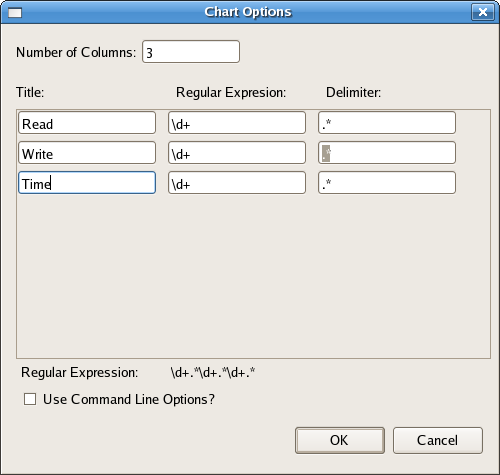
- Stop - This option terminates the script thread associated with whichever script currently has the focus. (Shortcut: Ctrl+F9)
Window
- Open in New Window - This option opens a new instance of SystemTap GUI.
- Open Perspective - This submenu lists each of the available perspectives to open:
- IDE Perspective
- Graphing Perspective
- Dashboard Perspective
- Show Views - This submenus lists each of the available views to open:
- Preferences - Due to the breath of this topic it is covered in another section. Please see Preferences .

